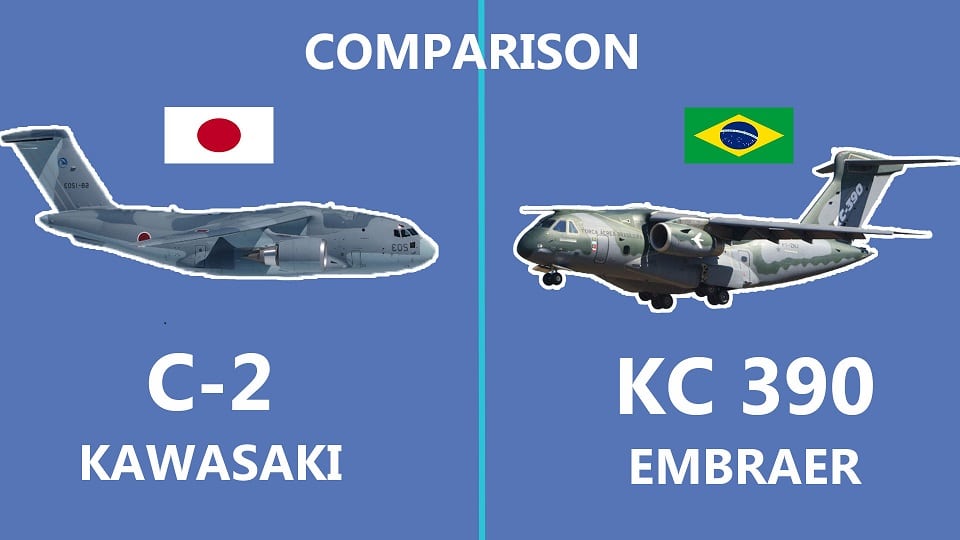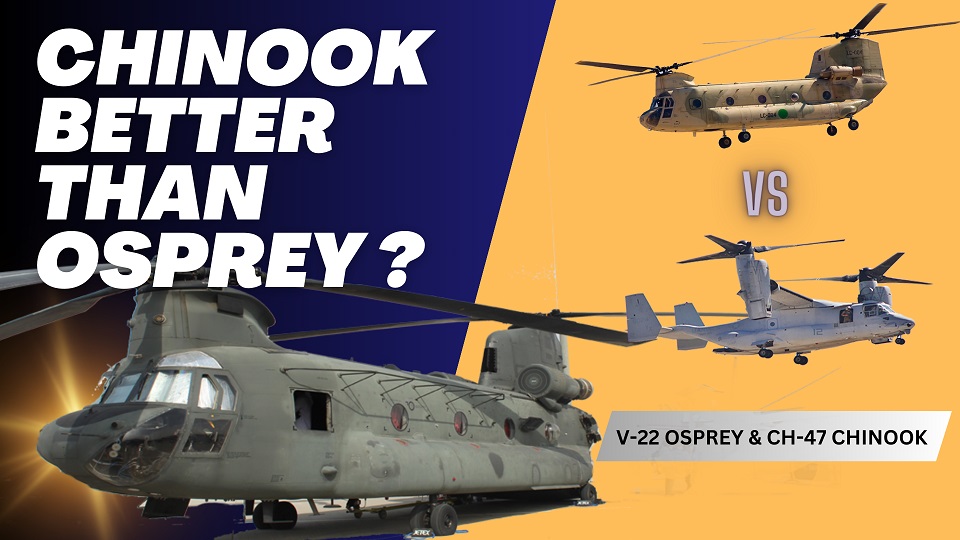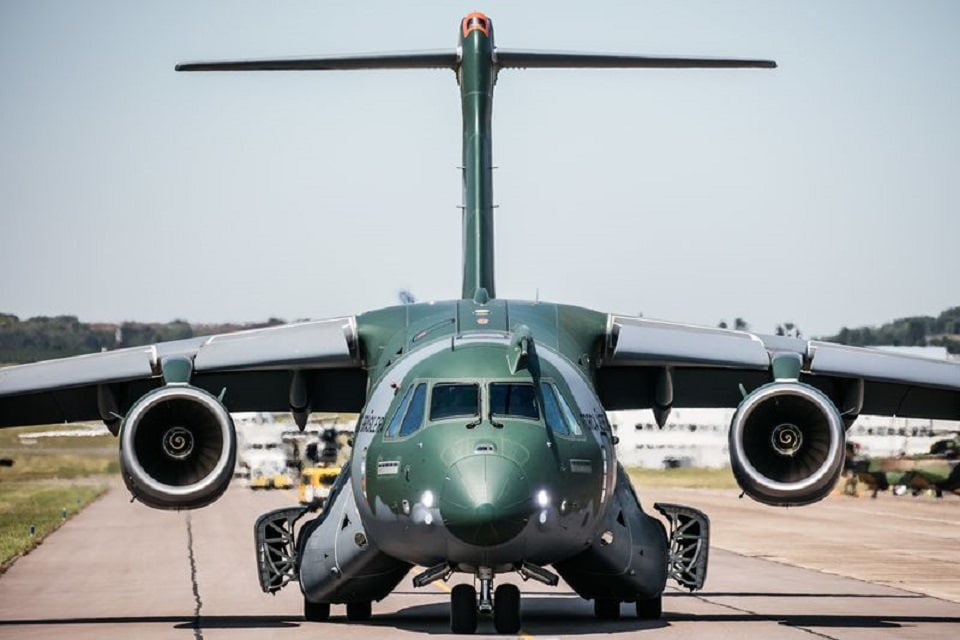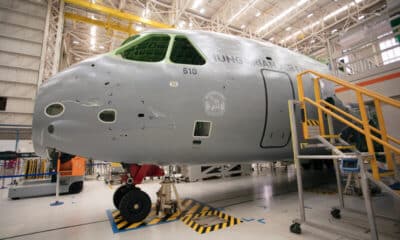Aircraft comparison
Aircraft comparison Brazil’s KC-390 vs Japan’s Kawasaki C-2
we’ll take a look at two different aircraft: the Brazilian-built Embraer KC 390 and the Japanese-built Kawasaki C2.

The military cargo plane is a crucial component of any nation’s defense since it helps move the troops and the military equipment to the necessary locations. Such military cargo jets are now in demand from several nations.
In this article, we’ll take a look at two different aircraft: the Brazilian-built Embraer KC 390 and the Japanese-built Kawasaki C2. We will comprehend aircraft specifications and their best-possible flying and serving capabilities for military needs.
Brazils Embraer KC -390
Embraer Aircraft, a Brazilian-based company with experience in the production of both private jets and commercial aircraft, is the manufacturer of the KC 390. A medium-sized twin-engine military transport aircraft, the KC 390. As of right now, it is the heaviest aircraft Embraer has ever produced.
China’s TP500 freight drone makes its maiden flight.(Opens in a new browser tab)
In order to identify the aircraft specifically, it was given a ‘Millennium’ name during the Dubai air show 2019. The Brazilian government has placed an order for 28 aircraft to replace the Brazilian Air Force‘s outdated C130s. These aircraft are also available on the global market. The Portuguese government is now evaluating the purchase of the aircraft.
This aircraft is a direct rival to the Lockheed Martin C130 and the Kawasaki, and it is ideal for multiple tasks.
Since this aircraft is being upgraded with a new avionics system that makes it even better, Embraer has experience in the aviation industry.
the Government of Brazil ordered 28 C-390s with the intention of progressively replacing the Brazilian Air Force’s cargo aircraft fleet, including its C-130s. The first C-390 was officially delivered to the Brazilian Air Force on 4 September 2019. The fleet of C-390s will be operated from Anápolis Air Force Base by the 1st Troop Transportation Group (1º GTT) Zeus and in Rio de Janeiro by the 1st/1st GT Gordo. The C-390 has been marketed as a jet-powered alternative to the C-130 Hercules produced by Lockheed Martin. In April 2013, Brazil, Portugal, Hungary, Argentina, Chile, Colombia, and the Czech Republic signed agreements for a total of 60 C-390s.
Japan’s Kawasaki C-2
It is a medium-sized, twin-turboprop, long-range, high-speed military transport aircraft designed and produced by Kawasaki Aerospace Company. The C-2 officially started working for the Japan Air Self-Defense Force in June 2016. In comparison with the older C-1 that it replaces, the C-2 can carry payloads up to four times heavier, such as MIM-104 Patriot surface-to-air missile batteries and Mitsubishi H-60 helicopters. Between 2020 and 2030, Kawasaki said there would be a need for up to 100 freighters that could handle large loads. The Japanese Ministry of Defense declared the C-2’s development to be complete on March 27, 2017.
Maximum takeoff weight of 2,300 meters and a maximum payload of 37,600 kilogram Field Length for Takeoff at 141 Tonnes (310,851 lb) ability to travel on international flight routes. Two General Electric CF6-80C2K turbofan engines power the C-2. While the Kawasaki P-1 and the C-2’s fuselage share some components, the C-2’s fuselage is significantly larger allowing a huge internal cargo deck, which is equipped with an automated loading/unloading system to lessen the burden on humans and ground equipment.
According to reports, Kawasaki has been eager to sell the C-2 outside of the domestic market. The C-2 has few competitors on the global market because it is one of just a few production-level aircraft that can perform its duty in the strategic airlift role, together with the Airbus A400M Atlas and the Ilyushin Il-76. In 2021, the C-2 was promoted at the Dubai Airshow to interested countries, including the UAE.
KC390 and C2 aircraft Specification
- The C2 can transport 120 personnel, compared to the KC 390s 80.
- Additionally, KC 390 can hold up to 7 463 L pallets, whereas C2 can hold up to 8 463 L pallets.
- The Kawasaki C2 is 144 feet long, whereas the Embraer KC 390 is 115 feet long.
- The C2 has a wingspan of 145 feet, while the KC 390’s is 115 feet.
- The C2 is 46 feet 7 inches tall, while the Embraer has a height of 38 feet.
- Additionally, the C2 has a take-off weight of 141,400 kg compared to the KC 390’s maximum take-off weight of around 86,999 kg.
- The KC 390 can hold 23,000 kg of fuel, whereas the C2 can hold 34,523 kg.
- Two General Electric Cf6-80 turbofan engines, each capable of producing 265.7 kilotons of thrust, are used to power the Kawasaki C2.
- The IAE International Aero Engines powerplant that is used in the Embraer KC 390 can generate 139.4-kilo newtons of thrust from each engine.
- The Kawasaki C2 can travel at a top speed of about 920 km/h, whereas the Embraer C390 can travel at a top speed of 988 km/h.
- The Kawasaki C2 has a maximum range of 7,600 km (20 tonnes), while the Embraer KC 390 has a maximum range of 5,820 km (14 tonnes).
- The Kawaski C2 has an 8,500-kilometer ferry range, whereas the Embraer has a 9,800-kilometer range.
- The KC 390 can reach a height of 36,000 ft, whereas Kawaski C2 has a service ceiling of 43000 ft.
- There is an in-flight refueling system on each plane.
Conclusion :
Each aircraft is the pinnacle of its class and of technology. However, size does matter; the Kawasaki has a far greater range and cargo capacity than the KC 390 aircraft.
Comparing the two aircraft, the KC 390 is less expensive than the C2, making it more accessible to developing nations.
According to the most recent updates, the KC 390 will cost approximately $85 million, and the Kawasaki C2 will cost approximately $100 million.
| Specifications | Embraer KC-390 | Kawasaki C-2 |
| Crew | 3 | 3 |
| Length | 35.2 m (115ft) | 43.9 m (144ft) |
| Wingspan | 35.05 m (115 ft) | 44.4 m (145ft) |
| Height | 11.84 m (38ft) | 14.2 m (46ft) |
| Max takeoff weight | 86,999 kg (191,800 lb) | 41,400 kg (311,734 lb) |
| Powerplant | 2 × IAE V2500-E5 turbofan, 139.4 kN | 2 × General Electric CF6-80C2K1F turbofan engines, 265.7 kN |
| Maximum speed | 988 km/h (614 mph, 533 kn) | 920 km/h (570 mph, 500 kn) |
| Cruise speed | 870 km/h (540 mph, 470 kn) | 890 km/h (550 mph, 480 kn) |
| Ferry range | 8,500 km (5,300 mi, 4,600 nmi) | 9,800 km (6,100 mi, 5,300 nmi) |
| Service ceiling | 11,000 m (36,000 ft) | 13,100 m (43,000ft) |

Aircraft comparison
Comparison between the KF-21 Boramae and TFX Kaan

The KF-21 Boramae and the TFX Kaan represent two prominent contenders in the realm of advanced fighter aircraft development. Both aircraft are envisioned to play significant roles in their respective nation’s air forces, offering cutting-edge capabilities and technologies tailored to modern combat environments.
In this article, we’ll delve into a detailed comparison between two cutting-edge fighter aircraft. Showcasing a formidable presence in the skies and a key player in the evolving landscape of global military aviation.
The KF-21 Boramae, is a fifth-generation multi-role fighter aircraft. Developed by the Korea Aerospace Industries (KAI). In April 2021, the inaugural prototype of the KF-21 Boramae was successfully finalized and revealed to the public. Subsequently, on the 19th of July 2022, the aircraft underwent its maiden test flight, marking a crucial milestone in its development. The commencement of manufacturing is slated for the year 2026.
The TAI Kaan, also referred to as TF-X, represents a stealthy, twin-engine, all-weather air superiority fighter under development by Turkish Aerospace Industries. Following successful taxi and ground tests conducted on March 16, 2023, the prototype was ceremoniously unveiled just two days later. On February 21, 2024, the inaugural flight of Kaan took place. TAI released a video showcasing a KAAN fighter jet ascending into the sky and subsequently landing back at the Mürted Airfield Command located in northern Ankara.
The KF-21 Boramae and the TAI TF-X, both being fifth-generation multi-role fighter aircraft, showcase remarkable advancements in aerospace technology. Let’s compare these two formidable fighters.
Beginning with their dimensions, the KF-21 boasts a length of 16.9 meters. whereas the TF-X is slightly larger, with a length of 21 meters.
The KF-21 has a wingspan of 11.2 meters, and a height of 4.7 meters. On the other hand, the TF-X measures slightly larger wingspan of 14 meters, and a height of 6 meters.
In terms of payload and operational flexibility, the KF-21 offers a maximum takeoff weight of 25,600 kg (56,400 lb).Conversely, the TF-X boasts a slightly higher maximum takeoff weight of 27,215 kg (60,000 lb), potentially allowing for increased armament and fuel carriage. This could translate to extended mission durations or enhanced combat capabilities, depending on operational requirements.
The KF-21 is equipped with two General Electric F414-GE-400K turbofans, capable of generating 57.8 kN of thrust. In comparison, the TF-X utilizes two General Electric F110-GE-129 Turbofans, producing 76.31 kN of thrust, potentially providing slightly higher performance capabilities.
Regarding performance, both aircraft demonstrate impressive capabilities. The KF-21 achieves a maximum speed of Mach 1.81, while the TF-X closely matches this with a maximum speed of Mach 1.8.
“The KF-21 boasts an impressive service ceiling of 64,961 feet (19,800 meters), surpassing the TF-X’s service ceiling of 55,000 feet (17,000 meters). This makes the KF-21 capable of operating at higher altitudes, potentially offering advantages in various mission scenarios.
KF-21 is equipped with state-of-the-art features such as an AESA radar, advanced avionics, and precision weaponry. Boasting 10 hardpoints for weapons deployment, high maneuverability, enhanced survivability, and a configuration with single tandem aircraft seats, the KF-21 ensures high operational efficiency in diverse mission scenarios.
Anticipated to integrate cutting-edge technologies, including a next-generation active electronically scanned array (AESA) radar system, sophisticated communications systems, and superior electronic warfare capabilities, the KAAN heralds a new era in Turkish military aviation. Advanced stealth features such as radar-absorbing materials and state-of-the-art coatings contribute to its reduced radar cross-section, enhancing its survivability in contested environments.
According to the report, UAE’s Economic Council had sent a letter to South Korea’s Office of National Security explaining Abu Dhabi’s desire for direct cooperation on the development of the KF-21. Surprisingly, the letter allegedly requested that Abu Dhabi replace Indonesia’s investment in the program.
TAI, the lead contractor for the KAAN fifth-generation fighter jet development programme, plans to supply 20 KAAN Block 10 fighter jets to the Turkish Air Force by 2028 after taxi trials conclude in March. With an eye towards the future, the second prototype (P1), which will cover the full flight envelope and serve as a closer approximation to the intended production aircraft, is slated for takeoff in 2025. The anticipated third aircraft flight in 2026 and the delivery of follow-on blocks by 2034 are among the upcoming benchmarks.
Aircraft comparison
Osprey is faster than Chinook helicopter ?

In this article, we’ll delve into two distinct military aircraft that have played essential roles in United Air Force defense. Both aircraft have unique characteristics in terms of usage and flying capabilities. One is capable of vertical takeoff and flies like an aircraft, while the other is a helicopter with two tandem rotors. Let’s explore each of these aircraft in detail.
The speed of helicopters can vary depending on several factors such as their design, engine power, payload, and mission requirements. Generally speaking, the Osprey (specifically referring to the V-22 Osprey) is faster than the Chinook helicopter.
The V-22 Osprey is a tiltrotor aircraft, meaning it can take off and land vertically like a helicopter but also tilt its rotors forward to fly like an airplane. This design allows the Osprey to achieve higher speeds compared to conventional helicopters. The cruising speed of the V-22 Osprey is around 241 knots (277 mph or 446 km/h).
On the other hand, the Chinook helicopter, such as the Boeing CH-47 Chinook, has a cruising speed typically around 170 knots (196 mph or 315 km/h). While the Chinook is a highly capable and versatile helicopter known for its heavy-lift capabilities and reliability, it generally operates at lower speeds compared to the Osprey.
The comparison between an Osprey and a Chinook helicopter involves contrasting two distinct aircraft with different designs, capabilities, and purposes:
MV-22 Osprey details:
The Osprey has garnered significant controversy since its inaugural flight, primarily stemming from issues associated with its tiltrotor design. These challenges have led to several incidents and crashes, resulting in the tragic loss of pilots and crew members and prompting multiple groundings of the aircraft.
However, efforts are underway to address these technical issues swiftly, with plans to rectify the problems and resume flights promptly. Despite these setbacks, the Osprey remains crucial in operational contexts, offering enhanced capabilities for transporting both cargo and crew members, underscoring its pivotal role in various missions.
Except for the United States and Japan, no other country has been granted authorization to utilize the Osprey aircraft. Its unique design and specialized nature, being built in the United States, likely necessitate governmental permission for export to other nations.
The Osprey stands out for its groundbreaking design and innovation, featuring the ability to transition from vertical to horizontal rotor positions while also generating thrust like a conventional aircraft.
- MV-22 Osprey:
- The MV-22 Osprey is a tiltrotor aircraft, meaning it can take off and land like a helicopter but fly like a fixed-wing aircraft once airborne.
- It’s primarily used for vertical takeoff and landing (VTOL), troop transport, cargo transport, and aerial refueling.
- The Osprey has a unique ability to combine the vertical lift capability of a helicopter with the speed and range of a turboprop aircraft.
- It can carry up to 24 troops or 20,000 pounds of internal cargo and has a top speed of around 315 miles per hour (507 km/h).
- The Osprey is utilized by the U.S. Marine Corps, U.S. Air Force Special Operations Command, and other military forces around the world.
Boeing CH-47 Chinook:
The Chinook helicopter stands as a testament to unparalleled engineering and innovation, making it one of the most distinctive aircraft ever constructed. Since its inception, no other nation has attempted to replicate its singular design, owing to the extraordinary precision and aerospace technology required for its construction. This helicopter, revered as an engineering marvel, has become a staple in major battlegrounds, renowned for its exceptional capacity to transport troops and cargo to any destination. Remarkably versatile, it operates seamlessly on both land and water surfaces, boasting an integrated floating system that enhances its capabilities even further.
Selected countries have been granted permission to utilize the Chinook helicopter, showcasing its global appeal and strategic importance. Furthermore, ongoing development efforts are underway to enhance the speed and carrying capacity of the next version of this iconic aircraft. Renowned for its exceptional safety record, the Chinook stands as one of the safest helicopters in operation today, with a remarkably low incidence of crashes. Its versatility is unmatched, making it an invaluable asset for operations in diverse terrains and environments.
- Boeing CH-47 Chinook:
- The Chinook is a tandem rotor helicopter, known for its distinctive twin-rotor design.
- It’s a heavy-lift helicopter primarily used for troop transportation, artillery emplacement, battlefield resupply, and various other missions.
- The Chinook has a rear loading ramp for cargo and troops, making it well-suited for quick loading and unloading.
- It can carry up to 55 troops or 24,000 pounds of cargo internally and has a top speed of around 170 miles per hour (274 km/h).
- The Chinook is widely used by the U.S. Army and various other military forces worldwide, including the UK, Canada, and others.
Comparison:
- Design: The Osprey is a tiltrotor aircraft, while the Chinook is a tandem-rotor helicopter.
- Speed and Range: The Osprey has a higher top speed and longer range compared to the Chinook due to its fixed-wing aircraft capabilities.
- Payload Capacity: The Chinook generally has a higher payload capacity for both troops and cargo compared to the Osprey.
- Versatility: While both aircraft are versatile in their own right, Osprey’s ability to take off and land vertically as well as fly at high speeds over long distances gives it a unique advantage in certain scenarios. However, the Chinook’s ability to carry larger payloads makes it better suited for heavy lift operations.
- Cost and Maintenance: Maintenance and operating costs may vary between the two aircraft, with tiltrotor technology typically being more complex than traditional helicopter designs.
Aircraft comparison
Comparison of Osprey vs Chinook Helicopter

Helicopters play a crucial role in military and civilian operations worldwide, providing vertical take-off and landing capabilities, versatility, and mobility in various missions.
Among the widely recognized helicopters in military service are the Osprey and Chinook. Both have distinct designs and capabilities, tailored to meet specific operational requirements. In this comparison, we will delve into the features, capabilities, and roles of the Osprey and Chinook helicopters, examining their differences and strengths.
The V-22 Osprey is a tiltrotor aircraft, meaning it can take off and land vertically like a helicopter but also tilt its rotors forward to fly like an airplane. This design allows the Osprey to achieve higher speeds compared to conventional helicopters. The cruising speed of the V-22 Osprey is around 241 knots (277 mph or 446 km/h).
On the other hand, the Chinook helicopter, such as the Boeing CH-47 Chinook, has a cruising speed typically around 170 knots (196 mph or 315 km/h). While the Chinook is a highly capable and versatile helicopter known for its heavy-lift capabilities and reliability, it generally operates at lower speeds compared to the Osprey.
The comparison between an Osprey and a Chinook helicopter involves contrasting two distinct aircraft with different designs, capabilities, and purposes:
Dimensions:
- The Osprey has a length of 57 ft 4 in (17.48 m). while Chinook is significantly larger, with a length of 98 ft (30 m).
- Performance:
- The Osprey boasts a maximum speed of 275 knots (316 mph) and a range of 879 nautical miles (1,012 mi), making it faster and having a longer range compared to the Chinook.
- The Chinook has a maximum speed of 170 knots (196 mph) and a range of 400 nautical miles (460 mi), providing commendable performance but falling short of the Osprey in terms of speed and range.
- Powerplant:
- The Osprey is powered by 2 × Rolls-Royce T406-AD-400 turboprop/turboshaft engines, providing ample power for its vertical and horizontal flight modes.
- The Chinook is equipped with 2 × Lycoming T55-GA-714A turboshaft engines, each delivering 4,733 shp (3,529 kW) of power.
- Weight and Payload Capacity:
- Osprey: The Osprey has an empty weight of 31,818 lb (14,432 kg) and a gross weight of 39,500 lb (17,917 kg). Its maximum take-off weight (VTOL) is 47,500 lb (21,546 kg).
- Chinook: The Chinook has an empty weight of 24,578 lb (11,148 kg) and a maximum takeoff weight of 50,000 lb (22,680 kg). This indicates that the Chinook can carry heavier payloads relative to its own weight compared to the Osprey.
In terms of performance, the Osprey has a higher rate of climb ranging from 2,320 to 4,000 feet per minute, whereas the Chinook boasts a rate of climb of 1,522 feet per minute.
Additionally, the Osprey has a service ceiling of 25,000 feet, allowing it to operate in high-altitude environments more effectively compared to the Chinook, which has a service ceiling of 20,000 feet.
Osprey can carry up to 24 troops or 20,000 pounds of internal cargo and has a top speed of around 315 miles per hour (507 km/h). While Chinook can carry up to 55 troops or 24,000 pounds of cargo internally and has a top speed of around 170 miles per hour (274 km/h).
The Osprey is utilized by the U.S. Marine Corps, U.S. Air Force Special Operations Command, and other military forces around the world.The Chinook is widely used by the U.S. Army and various other military forces worldwide, including the UK, Canada, and others.



























